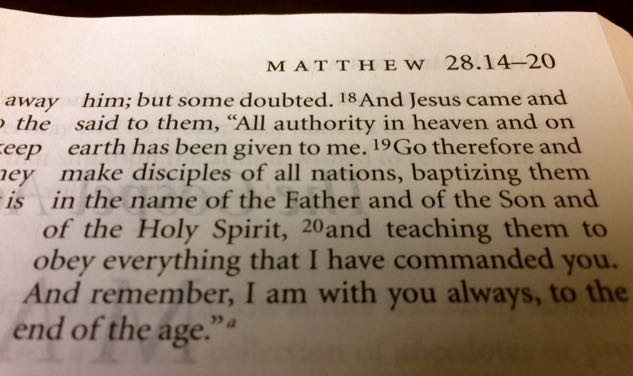
If you’re a Christian interested in discipleship, then today’s blog is for you. We’re going to take a look at the Great Commission in Matt. 28:19. Our examination of the passage will accomplish two complimentary goals. First, I’m going to walk you through how knowing a little Greek can help unpack the meaning of a passage. Second, I’m going argue that, according to Jesus, discipleship is made up of two components: baptism and teaching.
Jesus’ Command – Make Disciples
The heart of this passage is Jesus’ command, “make disciples.” In Greek, this is only verb in the sentence that’s a finite verb, that is, a verb that takes a subject. As such, it’s the heart of the sentence. Everything else relates to this statement in someway. This statement establishes the theme, the main point. The rest is commentary.
Many translations render the initial part of the sentence as “Go and make disciples.” This makes it sound like Jesus issues two commands. However, in Greek, “Go” is a participle. In English, participles are –ing verbs. This has led some to argue that a better translation would be “Going, make disciples.” Others argue that the participle is an imperative participle. For them, “Go and make disciples” is correct. Which is right?
To answer this question, I do need to get a little technical and explain some Greek language stuff. In the Greek NT, a participle can be one of three tenses: aorist, present, or perfect. In this case it is aorist. Typically, the aorist tense is used to communicate background information (for any Greek nerd reading, this is actually a function of perfective aspect). Background information is important because it provides the necessary context in order for something to make sense. This is similar to a backdrop on a stage. It’s easier to understand what’s happening when the scene is set against a proper background. The backdrop provides the audience with context. In other instances, the history of an event or an individual’s personal history serves as background information. Events and people actions often make more sense when seen against the backdrop of their history.
So when Jesus uses an aorist participle and puts it before the main verb, he does so to provide context. Of course, this raises an important question. How do we say this in English? Translation can be tricky. There is not always an easy answer. In fact, there are often several options that are equally as good. In this case, we might say, “When you go, make disciples.” Even though this translation doesn’t use an English participle for the Greek participle, it does accomplish the same purpose. It sets the backdrop. It creates context.
Jesus Explains the Command – Baptize and Teach
We’re not done with participles yet. Jesus’ command is followed by two more participles: baptizing and teaching. In these instances, Jesus has switched to present tense participles (imperfective aspect, again for you nerds out there). The present tense characterizes the action as “in progress.” This, combined with the fact that the participles follow the main verb, indicates that they are meant to unpack or further explain the main verb. If we were to create an outline based on this information, the participles would be two sub-points under the main point:
- Make Disciples.
- Baptizing.
- Teaching.
Thus, the participles anticipate a potential follow-up question. “Jesus, you said we are to make disciples. How do we do that?” The answer is, “By baptizing them and teaching them.”
Filling in the Rest of the Commission
As you’ve probably noticed, we’ve left out some parts of the Great Commission. Let’s finish the picture.
Jesus commanded his disciples to make disciples of all of the nations. Disciple making is understood against the backdrop of going into the whole world. From the beginning, God’s plan was to redeem all of humanity, not just Israel. Of course, it began with Israel. Jesus was a Jew. So were his first disciples. God, through Jesus, explained to Israel what it meant to be his people, his kingdom. Now it was their job to explain it to the rest of the world.
The first step to becoming a disciple is baptism. The NT bears witness to the fact that this was the universal practice of the early church. In fact, it was so important that even when God poured out his Spirit upon people, the next obvious step was baptism (Acts 10:44-48). Baptism symbolizes several things, among them being death to an old life and resurrection to a new one (Rom 6:3-4). In baptism, we are clothed with Christ (Gal 3:27). It was only natural that this was considered the obvious first step in becoming Jesus’ disciple. In baptism, we give public testimony to our transition from an old life to a new one. Our old life was not a life of discipleship. Now, we have entered a new life characterized by discipleship.
The second step to discipleship is teaching. In fact, this is the very heart of the meaning of disciple. While some emphasize the idea of discipleship as “following,” a disciple is more than merely a follower. A disciple is a pupil. Disciples followed a teacher so that they can learn from him. Without teachers and teaching, there is no discipleship. Jesus tasked his disciples with the responsibility of passing on what they had learned to the next generation of disciples. A person who claims to be a follower of Jesus but doesn’t listen and learn from his teaching is not a disciple. People who do not teach others what Jesus taught are not disciple makers.
Conclusion
Against the backdrop of going out into the world, Jesus commanded is disciples to make disciples. So how do we continue the practice of discipleship? According to this passage, there are two things. First, baptize those who want to become disciples. Second, teach them all the things that Jesus taught. If we practice these things, we fulfill the Great Commission. We are disciple makers.












